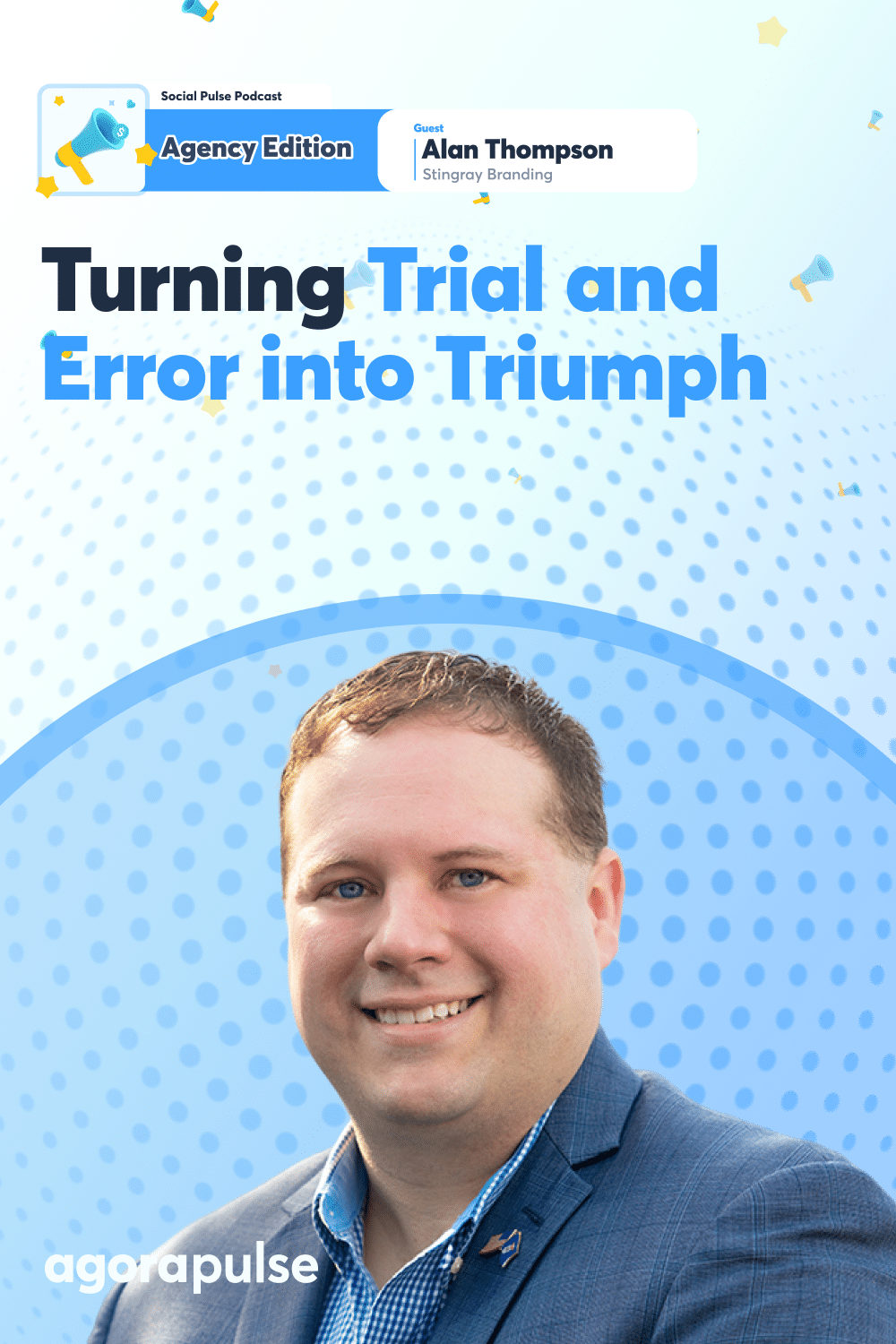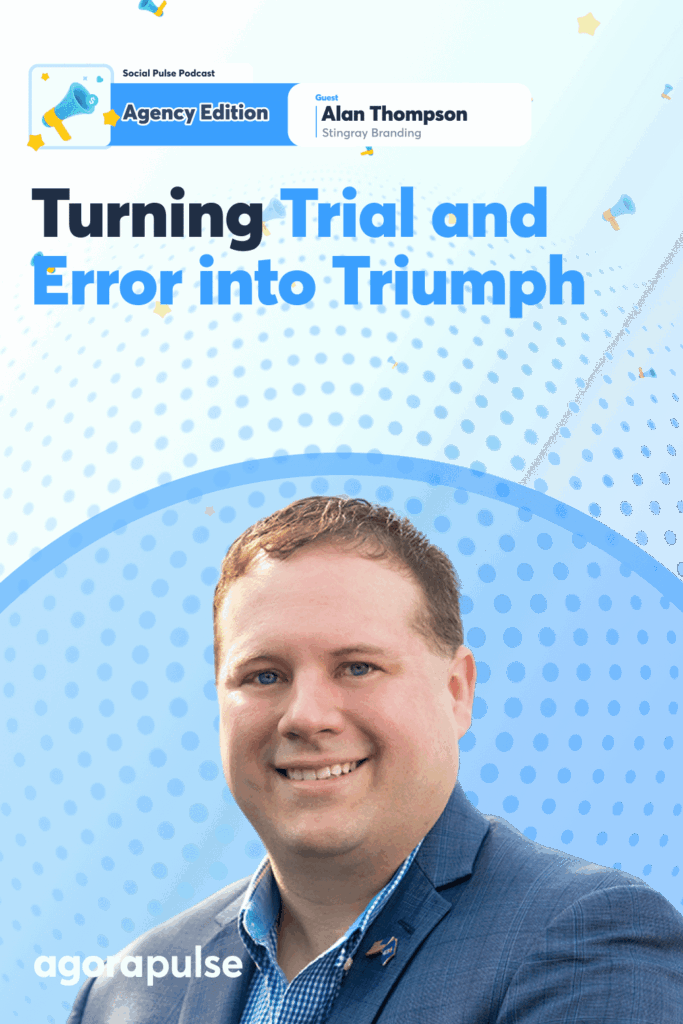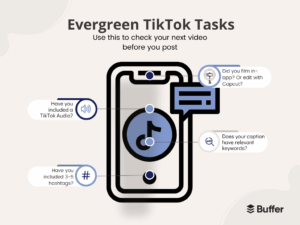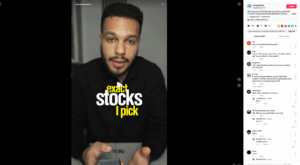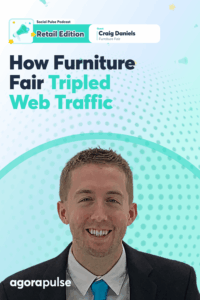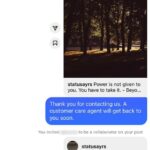Building a marketing agency from scratch can feel overwhelming. Alan Thompson, founder and CEO of Stingray Branding, built his agency from the ground up starting in 2008, learning every lesson the hard way. But he turned those lessons into a formula for success with three generations of small business owners in his family and service in both the US Army and Air Force Reserves. He shares his insights in this recap of Social Pulse Podcast: Agency Edition.
What motivated you to start an agency without any kind of formal marketing experience?
Alan Thompson: I launched in 2008. I went to basic training in the summer of 2008 and returned late fall almost December timeframe. And in the time that I was at basic training, the economy basically collapsed. And before I left for basic, I was a server assistant at a prestigious golf resort here in Charleston.
And I was making pretty good money. Had a focal point, thinking that would be my career potentially. The people who were servers there had been there for 30 years, and we’re all making pretty close to six figures a year. And I was like, “Yeah, that could be cool.” And I got back and I’m like, “Man, this isn’t enough money to pay my bills. This is an issue.”
I had built websites for my dad’s business and some others on Microsoft FrontPage in 9th and 10th grade of high school, and then took some multimedia web design classes in high school in my junior and senior year on Adobe Dreamweaver and all the Adobe products.
And a friend of mine was basically like, “Hey, for some extra cash, you should throw up an ad on Craigslist for our web design and see what happens.” And I landed like 30 clients in my first year, which sounds incredible and like a huge success story. And what I realized whenever I went back and ran the numbers a couple of years later, I was making about $3-4 an hour. I would’ve made more money working at McDonald’s, but it’s what launched the agency.
And so I started out as a web designer and had to essentially evolve over time by bringing on a copywriter and somebody to help with graphics and things of that nature. But, yeah, that’s what kicked it all off was the 2008 recession.
Could you share a story about an early mistake or a challenge that taught you a valuable lesson about running an agency?
Alan Thompson: I feel like every project I worked on for probably the first three years was that, but in particular, a couple of months in.
I met a guy who was doing rentals. So, he was running out of houses or running like an agent for house rentals throughout the world and contracted to build a website form as an HTML PHP style website that we built using Dreamweaver. I think it was somewhere in the ballpark of about 180 pages. Big eyes, right? I threw a number out there. I’m like, “Yeah, about X amount per page, and we’ll do this.” And I quoted ’em, and I think it was somewhere in the ballpark of 10 grand. It’s awesome. Yeah, we’ll do it. I’ll give you a little bit [of a down payment], and then whenever we’re done, I’ll pay the rest. I’m like, “Okay, sweet. Sounds cool.” And worked on that site for about six months, like missing dinners, not missing holidays, working weekends ’cause I was still working my full-time job too. Of course.
So, all this stuff happened on all my off time, and I learned a lot, right? ‘Cause I went into this with zero experience other than a couple of high school classes. And, of course, back then we didn’t have YouTube. YouTube wasn’t quite as extensive as it is now with all the educational videos it has. And there weren’t as many informational things to figure out.
You just had to learn it on your own. But playing around and going through the six months of building this thing out, and at the end of it, the guy moves to Canada. Can’t get an address for him, delete his phone number, and I never get paid.
The lessons that I learned from that were many:
- Charge a lot more.
- Get a contract.
- 50% down payments for every project moving forward.
To this day, those three things still happen. Make sure you’re being paid what you’re worth. Make sure you’re getting down payments upfront, and make sure you have a contract with a good address to follow after.
How are you developing the confidence to be able to walk up to somebody and say, “Hey, I can do this for you” while you’re still learning the ropes yourself?
Alan Thompson: Yeah, I had played around a lot. I built some different test websites. I built a website. At the time, I owned a Pontiac Fiero. I don’t know if you remember those fun things from back in the day, but I had one of those, and I was the president of the South Carolina Fiero Association. Built a website for that. Still have the one that I built for my dad’s business. Then, of course, my own. And I knew that I was a lot less expensive than others. I was undercutting the market, essentially freelancing at that point. And so I knew I had that as a leg-up. And then I knew that I had to overcome the experience issue. Whenever I’m going out to meetings, I always wear a suit. I was always in at least slacks in a long-sleeved button-down shirt. Oftentimes also with a tie in a jacket. It’s funny ’cause as I’ve grown, people always refer to the fact that I have a baby face.
I’ve always looked younger than I am, and thinking back on it now, whenever I was pitching these people at 18, I was probably 12. So they knew they were getting a steal by hiring me. I figured it was what they guessed. Of the clients that I landed, there were quite a few good ones. There was a local shoe chain basically here in Charleston that was very well known. They were a high-end shoe chain and landed them as a client, a few others. And of course, I started to snowball.
And I think I knew that I could believe in myself. I knew that I might lose money on this project. It’s probably going to be more work than what I’m selling it for to some extent, but I’m going to learn something through it, and no matter what, I’m going to get it done. And whenever I met with people, that was pretty much the pitch: “Hey, I’m new to this new business. But I know that I can build what you’re looking for, and I know I’m going to do a great job, and you’re going to love it whenever I’m done. So let’s just make it happen.”
And that worked pretty well. About a year into doing it, I came across a couple of other people, a couple married couple that the wife was a copywriter and the husband was a graphic teacher at the local college at the time, and partnered up with them and they started doing the web copy and graphics for all the websites. All I had to do was code ’em and lay ’em out and stuff.
And I think that helped my credibility a bunch. They were in their thirties at that time, so when everyone went into meetings, it was the trifecta team. And I probably was able to benefit from their age a little bit, and the fact that he was both experienced in the industry.
Did you put any systems or processes in place to help you ensure that you were delivering quality while you’re still learning how to do all this work?
Alan Thompson: Back then, there wasn’t a whole lot. We just went off the customer’s experience. We use analytics a lot. I don’t even know if we were using Google Analytics back then. I think it was like. Blue Host analytics, maybe or something. It was like the analytics from the server.
You could watch the bandwidth and things of that nature. And I think it counted the hits, and back in the day, remember the hit counters. We were using those things. We use that, and our project management system is Microsoft OneNote. We had a shared one. Yeah, we shared OneNote-like notebooks. We had a notebook for each client. We would all just put our hours into that, and the passwords and different stuff we needed, and annotate it all in there. And, at some point, I got the privilege of converting all that stuff over to an actual project management system.
So that was fun.
Whenever we went into a project, we would ensure that if we could make a profit, that’d be fantastic. But if we can make a great product, then that’s what matters. And that was always the driving factor: the client’s satisfaction. And we just started getting referral to referrals back in the day when we first started just doing web design. So I didn’t have any understanding at that point of paid ads and yellow pages back then or any of the stuff that was coming out—Google, SEO, none of that stuff was within my wheelhouse.
So everything we got was off word of mouth, going to networking events and groups, and just doing a good job and letting those stories sell you was the way that we grew for the first.
Honestly, almost the first 10 years being in the business, we didn’t move into actual marketing services until after 2016. So eight years.
How did you figure out pricing and services when you were just starting out?
Alan Thompson: Yeah, whenever I had the three partners or the two other partners for the three-way team, we each had our own prices basically. So the copywriter would set her price, and the graphic designer would set his price. I would have my price for the time to code. We’d add it all together and put a profit margin on top of it. And it’s easy to work whenever you’re that small, if you’re making a profit or not, and even if you go over, you don’t have any staff you have to pay the overage on. It’s just your own time that you’re going over.
But as it grew, we paid attention to what other people were charging. Started increasing based on the value we could prove that we could do. And we would get feedback, right? If you’re routinely getting told, “Oh man, that’s such a great price. You guys are such a great value.” Then, that upgrades a year, undercharging usually, so it’s time to go up. And then looking through, as we started to bring on employees and things of that nature, that was one of the challenges that, honestly, until I went to the University of Florida and graduated with a business degree, I did not understand pricing and a service-based business, right? And a product is rather easy, right? You have your cost of goods, you have your fixed cost, and then you can add your profit margin to it. A service-based business like ours, and marketing, do you charge based on value? Do you charge based on the time that you’re paying your staff? Do you charge for the cost that you’re putting into it?
There are so many different variables that you can base your pricing on. And honestly, until I graduated, I didn’t grasp an understanding and create the right shift there. It’s only been the last handful of years that we’ve started to see. True profit margin growth, and not working on a zero-based budget. Which is unfortunate, right? ‘Cause you’re so many years in the industry, and that’s probably one of the downfalls, that looking back now, starting this from the ground up and never getting any mentorship or education from another business owner, right? I didn’t even learn about mentorship until a few years ago, and implementing that if I had, it would’ve probably saved me a ton of effort, and we would be miles ahead of where we are now.
Alan Thompson: So a lot of everything we do is third-party backed with transparent reporting. We see the same reports that our customers do. We want to make sure that the systems that we’re utilizing for social media scheduling and SEO, and all those things that they all have good reporting metrics and that those are delivered to us just like they’re delivered to the client. And that we’re sharing those same reports with our clients.
Based on that, we will create the strategy to either optimize and do more of things that are working well, or we’ll cut out the things that aren’t, that are underachieving.
And then once we set up a solid, good marketing system, that company is growing and grows to a level that they would no longer necessarily need to be outsourcing their marketing, but instead need to start looking at bringing that internal, we’ll help with training the marketing team that they bring in, or the marketing person they bring in the sales team through the 10 x partnership that we have and making sure that business is built for scalability.
So, our goal is to essentially work ourselves out of a job over the course of five to 10 years of partnering with a business.
Alan Thompson: Yeah, absolutely. Looking back, like you touched on earlier, mentorship is going to be a big deal.
I wish that I’d had that in place way back when. And then I think for any business in general—but definitely for agencies—a project management system will make or break your agency, and setting it up correctly. I think that it’s easy to start Googling around and find stuff. It’s easy. It’s easy to find a project management system. It’s a whole different ballgame to set it up correctly, and whenever you’re small and you’re first implementing that, you don’t think through all the things like making sure the descriptions are in there for every task, for how you want it done. How do you want everything systematized? How do you want to make sure that a brand new intern comes on and replaces the person that’s been doing it for the last five years, that brand new intern does it the exact same way that the five-year senior, tenure person is doing it?
So, taking the time to properly set everything up has been a massive overhaul challenge for us that I wish we had put into place in the very beginning, and not necessarily built all of our systems with the understanding that we were doing the work. I already know how to do this. I don’t need to have a 30-step guide on what to do here?
As soon as you bring in that new person, you need a 30-step guide. And then in a CRM, I didn’t learn about CRMs until, I don’t know, 12-13 years into this ballgame. And I look back at the number of people that I make contact with at different networking events and leads we had, and so on. That didn’t close from the first eight years or so of being in business. And, man, if I had all those people in a CRM, whew, the gold might not be sitting on today. So for any agency or business, that’s a huge recommendation that we always tell ’em. Get your CRM set up correctly.
Get your automations built out, get your sales process built out, automate everything you possibly can, and start building that stockpile of contacts and assets you’re going to have. And then culture, I think there’s a huge thing with marketing agencies.
There are so many different agency types that are out there. You have your boutiques that they’re just making the posts, handling the emails, and taking that off the business owner. And I’m making sure that business looks good. And you have your freelancers, you have all these different types.
One thing that we shifted to over the last few years is that we wanted to be results-driven. We were operating on the lower end of the market, trying to go after volume and just trying to be that agency that was like, “Yeah, you don’t know, we’ll take all this stuff off your hands. You don’t have to do it. We have the expertise, we can help you with it, but not measuring the backend of everything.” And we shifted that over the last 24 months or so into, hey, look, we’re here to help you have results. That’s the goal that we want to have, the conversations we want to have. And at the end of the day, that’s what you’re going to measure us by anyway, right? Even if we’re selling you the $200 a month social media package, six months from now, the conversation is still going to be, What have I gotten from this?
So, if that’s going to be the conversation either way, we might as well go ahead and sell the services and build in the processes to deliver that from day one. So we stopped targeting the lower end of the market and went after the com and have started going after the companies, that’s their goal. They’re looking for growth, they’re looking for expertise. They want value back out of what they’re paying for. And it’s helped tremendously, we’ve seen. Basically, every month we’ve signed our largest client ever, every single month. We seem to exceed that, and they’re all still with us. They’re all still going along, and the strategies that we’re using are working fantastically. Pick who you want to be, and that doesn’t always need to be the lowest and cheapest thing, and then make sure that you’ve got a solid system in place to track what you’re doing to measure the expectation that you set in the initial sales process.
Any other advice that you’d want to share with someone just starting on their journey of building an AI or an agency?
Alan Thompson: Yeah, I think whenever we look at these tools and technologies that really can make a difference for an agency.
Another one that stands out—obviously, we’re all hearing about AI, right? That’s the big hot topic right now. And what people focus on AI for are, of course, ChatGPT and content creation and things of that nature. But what we found that’s been super helpful is AI for documentation.
We utilize a system called Scribe. It’s fantastic. It’s out there. And as we’re doing things, our team will just literally just click a button, start scribing, and it will screenshot and document every single click that you do and everything that you type for the entire process. And it can record up to 300 steps. So we’ll go through the process of setting up a Facebook page or doing SEO or launching a website, and we can document, literally click by the instructions on what to do, and then turn that over to whoever we onboard.
So you take your onboarding process like that has been a, I think, for a lot of agencies is a huge struggle is getting somebody caught up with speed with how, and they want all their little things done. You can cut that onboarding time down to almost nothing because you train them on your culture. Then, hey, here’s how you do this, right? Here’s your task, and here’s your step-by-step instructions. Go follow the instructions and show ’em once. Give ’em the AI, the documentation, monitor, and watch how they do it.
And then let ’em go and just follow it every single time. Don’t skip sets. And that’s probably been the biggest game changer in the last two years for our agency overall, because prior to it was almost impossible to get a system set up. And if you don’t have a reliable product that you can pitch to your clients, like if you can’t say, Hey, this is how it’s going to be done every single time, right? Then you don’t really have a product to sell. You need to know what the end product will be every time to be able to pitch that to a client accurately and set up proper expectations. So if you’re not utilizing AI for your documentation. You’re really missing out on probably one of the biggest opportunities that’s out there, right?
Because we don’t really want to get writing all of our content anyway. But you can use it for that. And then just looking over, as I look at the past couple of years and what I know now versus what I knew back then, spend as much time as you can absorbing information and focusing on what people really need.
I think that you get into marketing because you, or at least a lot of people, do, because they have skill sets with design, right? They can, they’re great graphic designers, they’re great videographers, photographers, web designers, and they have experience with WordPress. And as time has progressed, the barriers to entry to get into this industry continue to decrease. You continue to see more and more people getting into this, and what they don’t realize is that they tend to get into it initially because they think that what they’re being paid for and sought after is the design skillset.
And what I was told from another person, the founder assigned quickly, many years ago, that I think has helped my career, my agency grow over time, is that people, business owners in particular, don’t care what we do. They don’t care about what it takes to post on social media. The videos that we’re doing.
The website that we’re building, any of that stuff, what they care about is, does my phone ring? Does the dollar in my bank account go up, and am I getting more emails? So everything you do has to be from that perspective, ’cause at the end of the day, that’s what marketing is. It’s driving those three things, right? Or potentially, awareness for campaigns and social issues. So, make sure that you understand what that person wants and focus solely on it. Make sure that you deliver that. And if you don’t know how to do that in today’s world, we have so many opportunities between conferences and audiobooks, and podcasts like this that you can get that information in a moment’s notice and shift your whole life once you do.
How has your approach to running the agency evolved as you’ve gained additional experience and knowledge along the way?
Alan Thompson: I think deploying that in our tactics and understanding what we were being measured by has shifted all of our services, packages, etc.
And then the other thing that’s making a difference for us is whenever you get into business, or at least for me, I didn’t niche. I’ve never been a niche company, and you hear about it a lot on podcasts. You hear about it a lot in different marketing journals and so on. “You got a niche, find your niche, and go after it.” And that thought terrified me. I have clients in this market, and I don’t want to isolate any of those. I don’t want to nix myself of a sales opportunity or an opportunity to bring revenue.
As you know, looking back—and as I’ve pictured what we’re going to look like five years from now, and how AI’s going to impact us, and what we’re going to do to stay competitive with the continual reduction of barriers to entry, and so on is. I’ve identified there are a couple of industries that we thrive in, where we do a good job of exceeding their results: home services, restaurants, events, and member-based organizations. We have a recipe for, I’m recommending almost the same package every time I’m quoting somebody. It works every time we do it. We have mastered this, which is what it takes to grow and succeed, and thus realizing that we niched, we know exactly the four industries that we can have success in.
And those are the four industries that we have packages built for and that we target now. I ended up basically getting to a niche perspective or a niche focus without ever even realizing that I did it. So now that I know that I wish three or four years ago, I had started promoting myself that way, and I probably would have a lot more clients in those industries and be further ahead as well.
So that would be the other big shift in our approach, and how we’re running our agency now is that we are focusing on those four core industries and building products and services value around those four. So, for you, I don’t know that anybody necessarily has to do that right away, but once you get in, start paying attention to the industries that you have the most fun with, the ones that you enjoy, the ones that you can bring success to, the ones that you can have passion with. ‘Cause that’s going to be needed as you get into the grind of this industry and things change all the time.
If you can still have fun doing it because you enjoy the industries that you’re working with, I think that’ll carry you much further into your career.
Thanks for reading the highlights from this episode with Alan Thompson. Don’t forget to find the Social Pulse Podcast: Agency Edition on Apple and drop us a review. We’d love to know what you think. Don’t miss other editions of the Social Pulse Podcast like the Retail Edition, Hospitality Edition, and B2B Edition.
